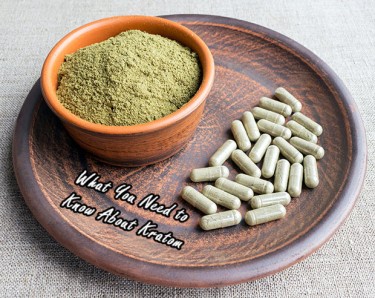Cannabis News
The Complete Guide to Building a Cannabis Brand with AI in 2024 and Beyond
Published
6 months agoon
By
admin

Practical Guide: Let’s build a Marijuana Brand using AI
Cannabis legalization is knocking on the door, and it’s just a matter of time before the powers that be realize they can’t keep this miracle plant under lock and key forever.
Sure, they might reschedule it, but mark my words, we’ll see full-blown descheduling in our lifetime. It might take a decade or two, but change is coming, and it’s coming fast.
Now, let’s talk about another game-changer: Artificial Intelligence. AI has been quietly infiltrating our lives, taking over the mundane tasks we used to slave over. It might not be perfect, but with a little human touch, AI can become one hell of an asset.
Just imagine the possibilities when we harness its power for our own benefit.
Sam Altman, the mastermind behind OpenAI, dropped a bombshell when he said the first solopreneur billionaire would be born from AI.
That’s a bold claim, but I believe it.
So, why not jump on this train and merge two of the hottest trends out there? Picture this: your very own cannabis brand, powered by the limitless potential of AI.
In this wild ride of an article, we’re going to walk you through the steps to make this dream a reality. We’ll dive into the nitty-gritty of building a brand from the ground up, all while leveraging the power of AI to give you a serious edge in the market.
So, buckle up, because we’re about to embark on a journey that could change your life. Are you ready to become the cannabis kingpin of the AI age?
Let’s find out.
Building a brand might seem like a daunting task, but let me tell you something: it’s easier than you think, especially when you’ve got AI on your side. With the right tools and a little bit of know-how, you can create a brand that stands out in the crowded cannabis market.
Here’s the deal, we’re going to break it down into nine fundamental steps:
-
Research Your Market and Audience
-
Define Your Brand Identity
-
Choose Your Brand Name and Logo
-
Create Your Brand’s Voice and Messaging
-
Design Visual Elements
-
Build Your Online Presence
-
Implement Your Brand Strategy
-
Promote Your Brand
-
Monitor and Adapt
We’re going to walk you through each of these steps, holding your hand the entire way. And here’s the best part: we’re going to build a faux brand together. That’s right, we’re going to create a brand from scratch, just to show you how it’s done. And if someone out there likes what they see and wants to run with it, be my guest. I won’t stand in your way.
So, are you ready to dive into the exciting world of cannabis brand building? I know I am. Let’s embark on this journey together and see where it takes us. Who knows, you might just end up with the next big thing in the cannabis industry. And if not, well, at least you’ll have a damn good time trying.
Alright, let’s talk about researching your market and audience. Now, I know what you’re thinking: “Research? That sounds like a lot of work.” But here’s the thing, with AI, it’s a breeze.
First up, you can use AI to gather data on your target market. We’re talking demographics, preferences, and buying habits. All the juicy details you need to create a brand that resonates with your audience.
But why stop there? You can even use AI to create a virtual stoner and interview them. That’s right, you can pick their brain and figure out what makes them tick. What are their pain points? What do they need? What do they desire? AI can help you get inside their head and understand what they value and how they communicate.
Now, I know you’re itching to get started, so here’s a SUPER PROMPT to help you out:
“Create a detailed persona of a typical cannabis user in [your target market]. Identify their demographics, preferences, pain points, needs, desires, values, and main forms of communication. Use this information to guide your brand’s research and development.”
Plug that into your favorite language model, and watch the magic happen. Trust me, with AI on your side, researching your market and audience has never been easier.
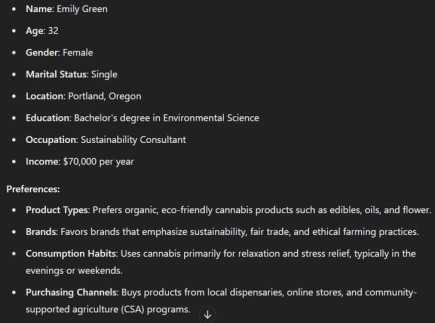
Now, let’s dive into brand identity.
This is where the rubber meets the road, and you get to define who you are as a brand. But before you start throwing around fancy words like “mission” and “vision,” you need to take a step back and understand what it is you’re actually selling.
Are you peddling products? Services? A little bit of both? Once you’ve got that figured out, you can start aligning your brand identity with your target market.
Now, let’s talk about your brand’s mission, vision, and core values. This is the stuff that’s going to set you apart from all the other cannabis brands out there. What do you stand for? What do you believe in? What makes you unique? These are the questions you need to answer if you want to create a brand that people can get behind.
But here’s the thing, you can’t just say you’re different. You need to prove it. That’s where your unique value proposition comes in. What sets you apart from the competition? Is it your superior product? Your commitment to sustainability? Your killer customer service? Whatever it is, make sure it’s something that your target market actually cares about.
Now, I know you’re probably thinking, “This sounds like a lot of work.” But don’t worry, I’ve got you covered. Here’s a SUPER PROMPT to help you get started:
“Create a brand identity for a cannabis company targeting [your target market]. Define the company’s mission, vision, and core values, and identify its unique value proposition. Ensure that the brand identity aligns with the target market’s needs, desires, and values.”
Plug that into your favorite AI tool, and watch as your brand identity takes shape. Remember, your brand identity is the foundation of everything you do, so take the time to get it right.
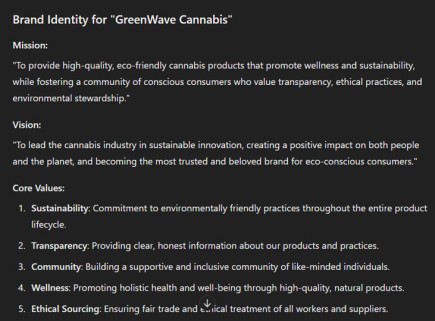
Alright, so you’ve got your brand identity all figured out. Now it’s time to put a name and a face to it. And by face, I mean logo. But don’t worry, you don’t need to be some kind of creative genius to come up with a killer brand name and logo. That’s what AI is for.
First up, let’s talk about your brand name. You want something that’s memorable, easy to pronounce, and reflects your brand identity. But coming up with a name can be tough. That’s where AI comes in. You can use tools like namelix.com or Jasper.ai to generate hundreds of potential names based on your brand keywords and preferences. And the best part? You don’t have to sift through all the terrible ones yourself. AI will do that for you.
But a name is just the beginning. You also need a color palette that reflects your brand’s personality and values. Again, AI has got you covered. Tools like Khroma.co and Coolors.co can generate color palettes based on your brand keywords and preferences. And if you’re feeling extra lazy, you can even use AI to suggest a logo based on your brand name and color palette.
But hold up, I know what you’re thinking. “How do I come up with a prompt for an image generator?” Don’t worry, that’s where language models like ChatGPT come in. You can use them to generate prompts based on your brand identity and preferences. Something like: “Generate a logo for a cannabis brand called [your brand name] using the colors [your color palette]. The logo should reflect the brand’s [your brand values] and appeal to [your target market].”
And just like that, you’ve got a complete brand identity, courtesy of AI. But don’t just take my word for it. Here’s a SUPER PROMPT to help you achieve all of this in one go:
“Create a complete brand identity for a cannabis company targeting [your target market]. Generate a brand name, color palette, and logo that reflects the brand’s mission, vision, and core values. Provide the final results in a single, cohesive brand identity document.”
Plug that into your favorite AI tool, and watch as your brand comes to life.
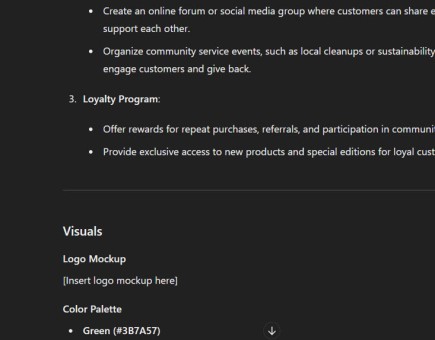
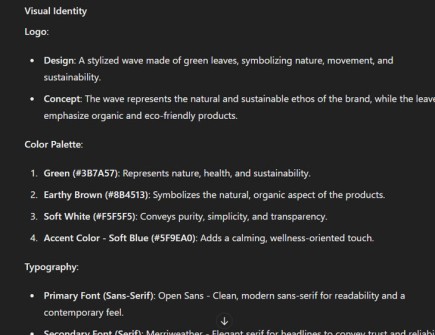
Alright, let’s talk about your brand’s voice and messaging. This is where you get to let your personality shine through and really connect with your audience. But what if you’re not sure what your brand’s personality is? Or how to communicate with your target market? Don’t worry, AI has got your back.
First things first, you need to establish your brand’s voice. Are you funny and irreverent? Serious and educational? Somewhere in between? AI can help you figure that out. Tools like IBM Watson Tone Analyzer and Adeptmind.ai can analyze your existing content and give you insights into your brand’s personality and tone. From there, you can use language models like GPT-3 to generate content that matches your brand’s voice.
But here’s the thing, you can’t just assume that your brand’s voice is resonating with your audience. That’s where A/B testing comes in. You can use AI to generate multiple versions of your messaging and test them out on your target market. See what works and what doesn’t, and refine your messaging accordingly.
And speaking of messaging, you need to make sure that your key messages are conveying your brand’s values and benefits. What do you want your audience to know about your brand? What makes you different from the competition? AI can help you craft messaging that speaks directly to your target market’s pain points and desires.
But perhaps most importantly, you need to have a clear set of business mantras that guide everything you do. What are the non-negotiables for your brand? What do you stand for? AI can help you distill your brand identity into a set of clear, concise mantras that you can use to guide your decision-making and communication.
So, ready to get started? Here’s a SUPER PROMPT to help you create your brand’s voice and messaging:
“Create a comprehensive brand voice and messaging guide for a cannabis company targeting [your target market]. Use AI tools to analyze the brand’s existing content and generate new content that matches the brand’s personality and tone. Craft key messages that convey the brand’s values and benefits, and distill the brand identity into a set of clear business mantras. Provide the final results in a single, cohesive document.”
Plug that into your favorite AI tool, and watch as your brand’s voice and messaging takes shape. And remember, your brand’s voice is what sets you apart from the competition. So make it count.
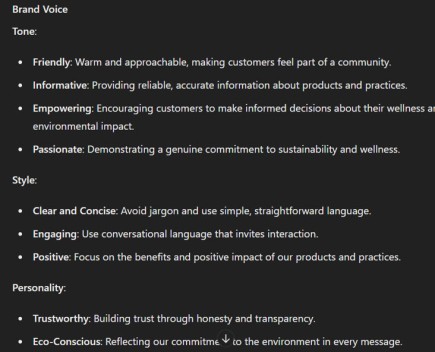
Alright, let’s talk about the fun part: designing your brand’s visual elements. This is where you get to let your creativity run wild and really bring your brand to life. But if you’re not a designer, don’t worry. AI has got you covered.
First up, you need to establish your brand’s color palette, typography, and design guidelines. This is the foundation of all your visual elements, so it’s important to get it right. You can use tools like Khroma.co and Fontjoy.com to generate color palettes and font pairings that match your brand’s personality and values. And if you’re not sure where to start, you can use AI-powered design tools like Canva and Crello to generate templates and guidelines for you.
But your visual elements don’t stop there. You also need to create things like business cards, packaging, and website design. Again, AI can help with that. Tools like Magicpattern.design and Patternpad.com can generate custom patterns and textures for your packaging and website. And if you need mockups, you can use AI-powered tools like Smartmockups.com and Mockupworld.co to generate them for you.
Once you’ve got your mockups, it’s time to bring them to life. If you’re using Figma, you can use AI-powered plugins like Autoflow and Automator to replicate your wireframes and designs. And if you’re building a website, you can use AI-powered builders like Elementor and Wix to create stunning designs with just a few clicks.
But perhaps most importantly, you need to make sure that your visual elements are consistent across all your channels. Whether it’s your website, your social media, or your packaging, your brand should be instantly recognizable. That’s where AI-powered brand management tools like Lucidpress and Bynder come in. They can help you create and manage your brand assets across all your channels, ensuring that your brand is always on point.
So, ready to get started? Here’s a SUPER PROMPT to help you create your brand’s visual elements:
“Create a comprehensive visual identity guide for a cannabis company targeting [your target market]. Use AI tools to generate color palettes, typography, and design guidelines that match the brand’s personality and values. Create mockups for business cards, packaging, and website design using AI-powered tools. Provide the final results in a single, cohesive document.”
Plug that into your favorite AI tool, and watch as your brand’s visual identity comes to life. And remember, your brand’s visual identity is what makes you stand out from the crowd. So make it count.
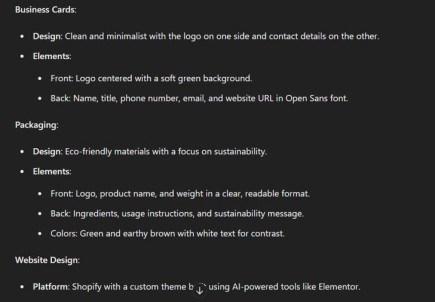
Alright, let’s talk about building your online presence. This is where you get to connect with your audience and really showcase what your brand is all about. But with so many channels and platforms out there, it can be overwhelming to know where to start. That’s where AI comes in.
First up, you need to create content that resonates with your audience. And I’m not talking about fluffy, generic content that doesn’t say anything. I’m talking about content that speaks directly to your customers’ pain points and needs. You can use AI-powered tools like Jasper.ai and Content Villain to generate articles, social media posts, and other types of content that are tailored to your target market. These tools can analyze your audience’s interests and behavior and create content that’s more likely to engage and convert them.
But creating content is just the first step. You also need to make sure that your content is being seen by the right people at the right time. That’s where social media planners like SocialChamp come in. These tools can help you schedule and automate your content across all your social media channels, ensuring that your brand is always top of mind for your audience.
But here’s the thing: you can’t just set it and forget it. You need to be constantly reviewing your metrics and adapting your strategy accordingly. Use AI-powered analytics tools like Sprout Social and Hootsuite to see when your customers are engaging with your content, where they’re hanging out online, and what kind of content they’re responding to. Then, use that information to refine your strategy and create even more targeted content.
And don’t forget about ads. I know, I know, ads can be annoying. But if you can create a positive revenue stream using ads, your organic systems will work even better. You can use AI-powered ad tools like Adext AI and Albert.ai to create and optimize your ad campaigns, ensuring that you’re getting the best possible ROI.
But perhaps most importantly, you need to build a funnel. Create a lead magnet, like an ebook or a free trial, and use it to collect emails and other contact information from your audience. Then, use AI-powered email marketing tools like Mailchimp and Constant Contact to nurture those leads and turn them into loyal customers.
So, ready to get started? Here’s a SUPER PROMPT to help you build your online presence:
“Create a comprehensive online presence strategy for a cannabis company targeting [your target market]. Build a funnel by creating a lead magnet and collecting emails using AI-powered email marketing tools. Provide the final results in a single, cohesive document.”
Plug that into your favorite AI tool, and watch as your online presence takes off. And remember, your online presence is what connects you with your audience. So make it count.
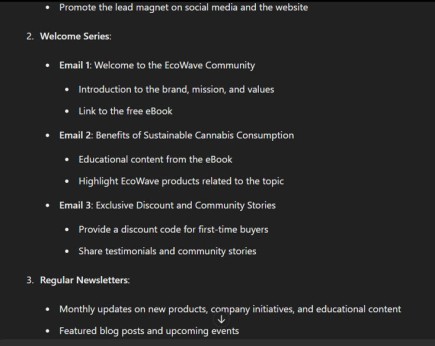
Alright, let’s wrap this up with the final three steps. You’ve done the hard work of creating your brand identity, designing your visual elements, and building your online presence. Now it’s time to put it all into action.
First up, you need to implement your brand strategy. This means making sure that every touchpoint with your customers, from your website to your packaging to your customer service, is consistent with your brand identity. You can use AI-powered tools like Lucidpress and Bynder to create and manage your brand assets, ensuring that everyone in your organization is on the same page.
But creating a great brand is only half the battle. You also need to promote it. And that’s where ads come in. You can use AI-powered ad tools like Adext AI and Albert.ai to create and optimize your ad campaigns, ensuring that you’re reaching the right people with the right message at the right time. But don’t just set it and forget it. Use AI-powered analytics tools to monitor your ad performance and adapt your strategy accordingly.
And finally, you need to monitor and adapt. Your brand is a living, breathing thing, and it needs to evolve with your customers’ needs and preferences. Use AI-powered analytics tools to track your brand’s performance across all channels, from your website to your social media to your ads. And don’t be afraid to make changes based on what you learn. Your brand should always be growing and improving.
Now, I know what you’re thinking. “But wait, these steps don’t necessarily require AI!” And you’re right. But here’s the thing: AI can make all of these steps easier and more effective. You can use AI to run your campaigns by a persona, test your content, and refine your work. It’s like having a personal assistant that never gets tired and never takes a day off.
So no excuses. Get to work, create something beautiful!
ARTIFICIAL INTELLIGENCE IN THE WEED INDUSTRY, READ ON..
You may like
-
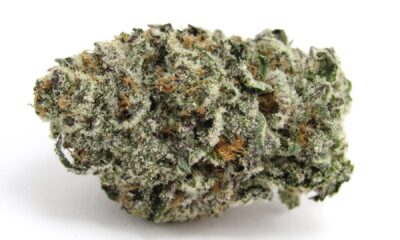

Get some rest on Modified Grapes—November’s Leafly HighLight
-
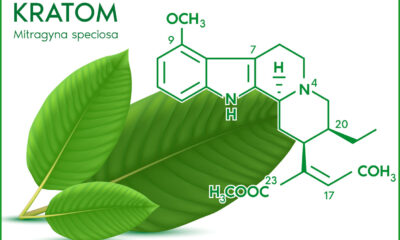

Is Kratom Addictive? Understanding Dependence, Risks, and Safe Usage
-


New Rule, December 5: Oregon Cannabis Retailers, Processors and Labor Peace Agreements
-


The CBD Dog Treat Guide
-


Trippin’ Golf Balls – Can Magic Mushrooms Help Your Golf Game?
-


Australian Broadcasting Corp Alleges Military Veterans Have Been Targeted By Medicinal Cannabis Companies Via Social Media & Offered Free “Product”
Cannabis News
Is Kratom Addictive? Understanding Dependence, Risks, and Safe Usage
Published
6 hours agoon
November 12, 2024By
admin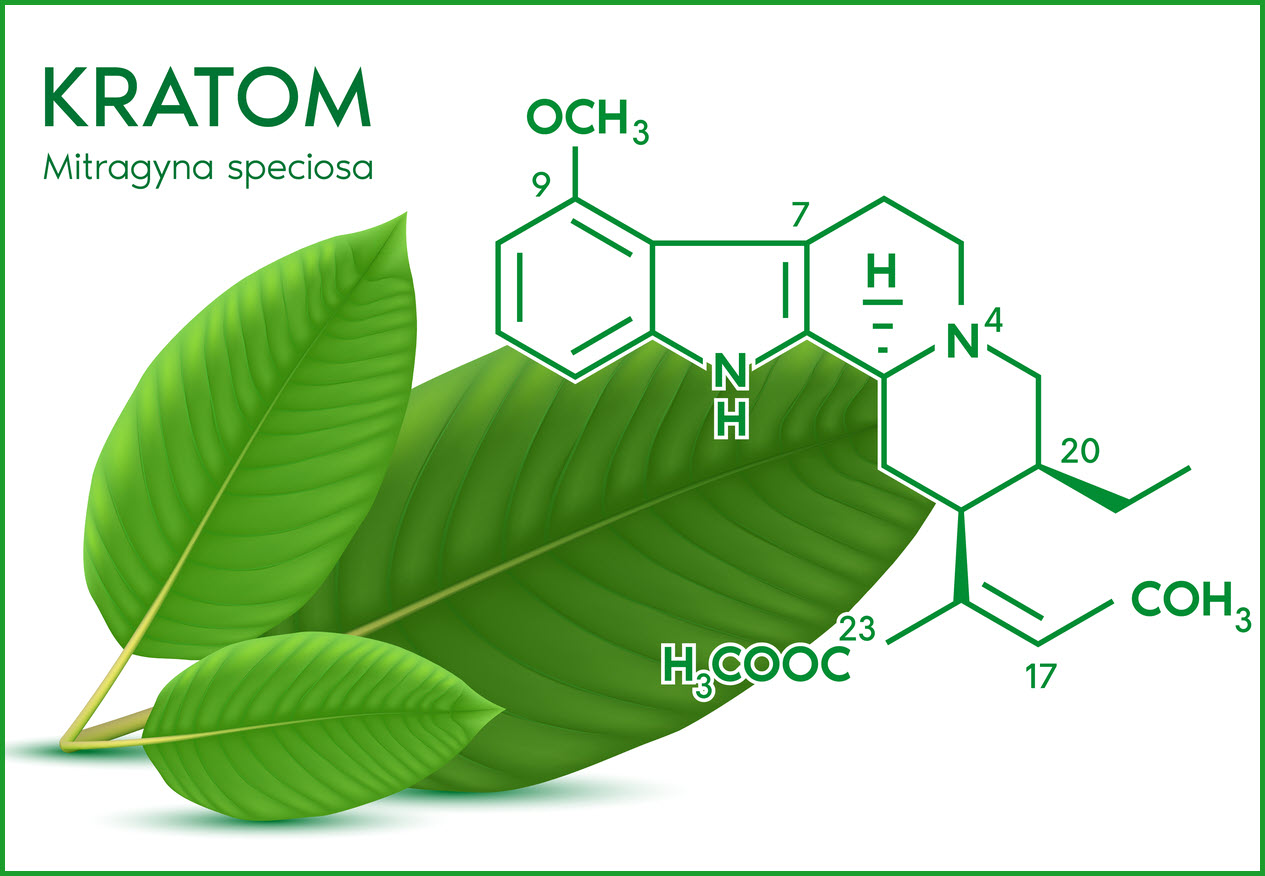
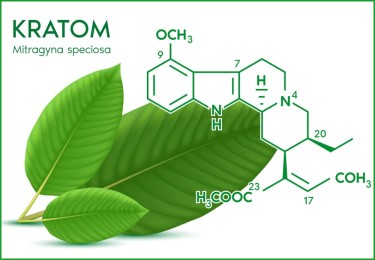
Is kratom addictive? Discover the potential for dependence on Kratom, the risks involved with its use, and how to approach its consumption responsibly.
From 2011 to 2017, over 1,800 calls to poison centers involved kratom in the U.S. This significant number highlights the concern regarding kratom addiction.
However, without Food and Drug Administration (FDA) oversight, and due to various consumption methods like teas and capsules, there are significant health risks. Safe use of kratom is now in question due to these issues.
Research debates how dependence develops, outlining signs like loss of control and withdrawal symptoms. These signs are seen in regular kratom users. Ironically, some people switch from drugs like heroin to kratom, looking for a legal alternative.
Understanding Kratom: Origins and Prevalence
Kratom comes from the Mitragyna speciosa tree in Southeast Asia. It can act like a stimulant or like opioids, based on how much you take. People use it in different ways, for a small energy boost or stronger effects at higher doses.
The legal status of kratom in the U.S. is complicated and changing. It’s a hot topic because some worry about its misuse. It’s still legal in several states. This shows how different places handle drug rules. The National Institute on Drug Abuse is looking into its medical benefits. But, the FDA hasn’t approved it for medical use yet. The DEA calls it a “drug of concern,” which means policies might change.
-
From 2011 to 2017, poison control centers in the U.S. got over 1,800 reports about kratom. This shows it’s widely used and might pose health risks.
-
Kratom’s main ingredients bind to opioid receptors very strongly, stronger than morphine even. This fact is key to understanding its effects.
-
As more people use kratom, more are reporting serious health problems. These include liver and heart issues, and tough withdrawal symptoms, particularly in those already sick.
The statistics show mounting worries about kratom in the U.S. As its use grows, it’s becoming more important to health policies and laws. What happens next will depend on further research and legal decisions.
Is Kratom Addictive: Investigating the Substance’s Nature
The question of kratom’s addictiveness focuses on how it affects brain receptors and its long-term health implications. The ongoing debate highlights concerns about dependence and the risk of addiction. Scientists are closely looking at these issues.
How Kratom Works in the Brain
Kratom’s main alkaloids, mitragynine and 7-hydroxymitragynine, bind to the brain’s opioid receptors, similar to painkillers and narcotics. This connection suggests a potential risk of dependence. These alkaloids are key to kratom’s pain relief but also point to possible addiction concerns, especially with frequent, high-dose usage.
Patterns and Consequences of Long-term Use
-
Using kratom often, especially in large doses, can increase the risk of dependence and intense withdrawal symptoms, similar to opioid withdrawal.
-
Although some use it for pain or to improve mood, long-term kratom users might see serious health problems, like liver damage and mental health issues.
-
Withdrawal symptoms, including irritability, nausea, and sleep problems, show kratom’s impact on one’s physical and mental health.
Assessment of Addiction Risks
Studies indicate a significant risk of addiction to kratom, especially with high doses or frequent use. Dependence develops as the body gets used to kratom, leading to tolerance and a need for more to feel its effects. Withdrawal symptoms emphasize this risk, as highlighted by health experts.
Physiological Effects: Kratom’s Impact on the Body
There is a lot of debate about the safety and use of kratom. This herbal extract comes from the Mitragyna speciosa plant. It has drawn attention for its possible harmful effects on the body. The FDA has issued many warnings about kratom, raising safety concerns.
-
Kratom Adverse Effects: Kratom users have reported side effects like nausea, vomiting, and confusion. More serious issues include high blood pressure and liver damage. These problems highlight the risks of using kratom.
-
Herbal Extract Safety: Some kratom products contain heavy metals and pathogens. These can cause severe health issues, including death. This shows the importance of safety in herbal products.
-
FDA Warnings and Regulations: The FDA has linked kratom to over 35 deaths and warns against using it. They point out the lack of medical uses and the risk of addiction.
-
Physiological Impact: Kratom’s effects depend on the dose and the user’s body. Yet, it can lead to dangerous outcomes like liver damage and seizures.
-
Safety Concerns from Authorities: Federal agencies like the DEA are worried about kratom’s safety. Although not a controlled substance, monitoring suggests users should be careful.
Kratom might offer temporary relief for some ailments, but it comes with significant risks. The FDA’s warnings should make people think twice. If considering kratom, it’s crucial to talk to a doctor first. Experts stress the need for safety and caution with herbal extracts.
Conclusion
Kratom’s role in health and regulation is complex, with views and research findings widely varied. Some people use kratom for its claimed health benefits, but it’s a hot topic. Experts advise caution and suggest consulting a doctor before using kratom due to the unclear effects.
Clinical studies using scores like SOWS and COWS haven’t confirmed withdrawal symptoms from kratom. This adds to the debate, especially when some users report withdrawal. This makes kratom a controversial subject among different findings and user experiences.
When it comes to treating opioid addiction, kratom can be both helpful and harmful. Some have used it successfully to fight addiction. Yet, some states have banned it. This highlights the need for regulations and consistent product quality. It also raises questions about kratom’s legal status due to mixed actions by authorities.
The situation shows how complex kratom is in the realm of substance use and law. Without clear evidence supporting either its benefits or risks, it poses a challenge. More research is needed to guide regulations and health advice. For now, anyone thinking of using kratom should be careful, seek medical advice, and keep up with laws and health guidelines.
WHAT IS KRATOM ANYWAY? READ ON…
Cannabis News
New Rule, December 5: Oregon Cannabis Retailers, Processors and Labor Peace Agreements
Published
7 hours agoon
November 12, 2024By
admin
Oregon’s Measure 119 passed last week, as expected. This means that as of December 5th, every OLCC licensed retailer, processor, researcher and testing lab must secure a labor peace agreement before OLCC will approve a new or renewal license application. The labor peace agreement must be with a “bona fide labor organization.”
I previewed M119 back in September, explaining:
Compulsory peace agreements aren’t anything new in cannabis, although it would be something different here in Oregon. California, for example, requires labor peace agreements for many of its cannabis licensees, and has for many years. We had clients struggle with the concept initially, and we saw some fumbled rollouts, but people eventually adjusted.
Measure 119 further provides that retailers and processors would be required to remain neutral, under the peace agreements, when labor organizations communicate with employees about collective bargaining rights “with any licensure or renewal application.”
M119 may be legally problematic
I’m not a First Amendment lawyer, but it’s not clear to me that an Oregon business can be constrained from speaking with employees– regardless of what M119 provides. Oregon’s speech protections are extremely broad, which is why we have a naked bike ride, tons of strip clubs and no campaign finance restrictions.
I’m also not a labor lawyer, but I’m told M119 could hit a snag on the National Labor Relations Act.
I’ve run these concepts by an Oregon First Amendment lawyer and a couple of labor lawyers, and all confirmed to me that M119 has real exposure. I found that feedback interesting, because M119 sponsors would have understood this when they set out signature gathering. Back in September, I wrote:
The United Food and Commercial Workers Local 555 spent a good deal of money to get Measure 119 on the ballot, rounding up some 163,000 signatures when only 117,173 were required. This follows on a stymied effort to get House Bill 3183 passed last year, which would have accomplished the same thing legislatively.
HB 3183 failed after a couple of advisory letters from the State of Oregon, Legislative Counsel Committee (see here and here). Those letters discussed preemption exposure for what is now M119 under the National Labor Relations Act, The Taft Hartley Act, and other federal laws. Oregon Business and Industry, the largest business group in the state, also submitted opposing testimony, highlighting legal exposure.
As to the First Amendment issues, anyone watching this is advised to follow litigation recently brought by Ctrl Alt Destroy, Inc., on a similar requirement in California.
So let’s see how that goes, and let’s see if anyone in the Oregon cannabis space wants to make a run at litigating M119. For now, credit to UFCW Local 555, I guess, for not giving up and for getting this thing on the ballot. And for having some fun by slipping a Rickroll into the voter pamphlet. I’m sure that won a few people over.
The OLCC process
I don’t have any information yet on what OLCC is going to do ahead of the December 5th deadline. It’s worth noting that, in addition to California, other recreational cannabis states including New York, New Jersey, Rhode Island, Connecticut and Delaware all have similar requirements. Most likely, OLCC will put out an FAQ page very soon that looks something like this and licensees will need to upload something or other to CAMP with respect to any post-December 5th application or renewal.
As far as OLCC licensees negotiating these agreements, the best approach would be to speak with experienced labor counsel. Labor law is highly specialized, and negotiating a labor peace agreement with any outfit claiming to be a “bona fide labor organization” is not a typical exercise.
For now, this is just one more thing for licensed cannabis businesses to comply with. Please reach out to us if you have any questions or need a referral.
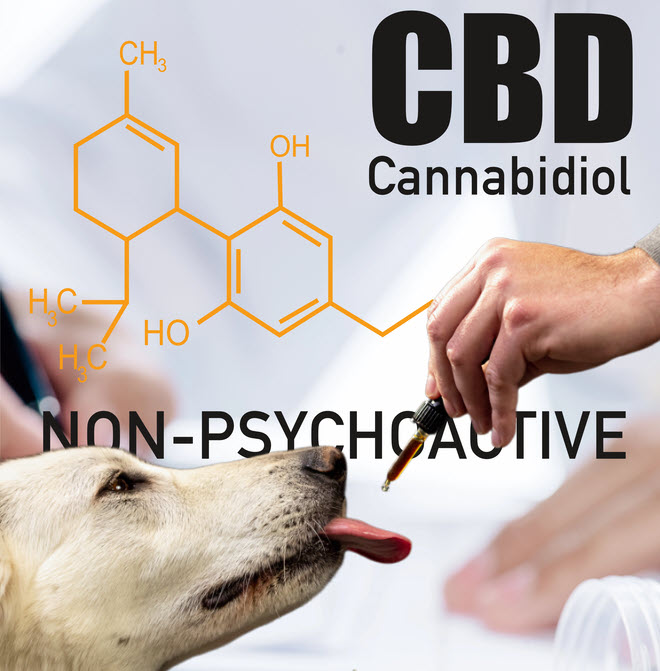
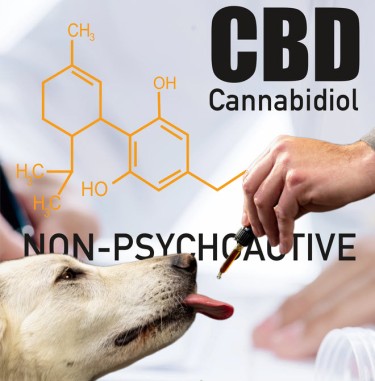
As the popularity of CBD (cannabidiol) continues to rise, many pet owners are exploring its potential benefits for their furry companions. CBD is derived from the hemp plant and is known for its therapeutic properties, which may help alleviate anxiety, pain, inflammation, and other health issues in dogs. However, when considering CBD treats for your dog, it’s crucial to understand the ingredients that go into these products. This article will delve into the essential ingredients to look for in CBD treats, their benefits, potential risks, and how to choose the right product for your canine friend.
Understanding CBD and Its Benefits for Dogs
Before we dive into the ingredients, it’s important to understand what CBD is and how it can benefit dogs. CBD is a non-psychoactive compound found in cannabis plants. Unlike THC (tetrahydrocannabinol), which can produce a “high,” CBD does not have intoxicating effects. Instead, it interacts with the endocannabinoid system (ECS) in both humans and animals, which plays a crucial role in regulating various physiological processes.
Potential Benefits of CBD for Dogs
-
Anxiety Relief: Many dogs experience anxiety due to various factors such as loud noises, separation from their owners, or changes in their environment. CBD may help reduce anxiety levels by promoting a sense of calm.
Choosing the Right CBD Treats
When selecting CBD treats for your dog, it’s essential to look beyond just the CBD content. The overall quality of the treat is equally important. Here are some key ingredients you should be aware of:
1. High-Quality CBD Oil
The foundation of any good CBD treat is the quality of the CBD oil used. Look for treats that contain:
-
Full-Spectrum or Broad-Spectrum CBD: Full-spectrum products contain all cannabinoids found in the hemp plant, including trace amounts of THC (below 0.3% as per legal standards). Broad-spectrum products contain multiple cannabinoids but no THC. Both types can provide an “entourage effect,” enhancing the therapeutic benefits.
2. Natural Ingredients
Just like human food, the ingredients in your dog’s treats matter significantly. Look for treats made with natural ingredients rather than artificial additives or preservatives. Here are some beneficial components:
Whole grains like oat flour or brown rice flour provide essential nutrients and fiber that support digestive health. They are also a good source of energy for active dogs.
Healthy fats are vital for maintaining your dog’s coat and skin health. Ingredients like coconut oil or peanut butter not only enhance flavor but also provide beneficial fatty acids that support overall well-being.
Incorporating fruits and vegetables into your dog’s treats can boost their nutritional value:
To make treats more appealing without resorting to artificial flavors, look for natural flavorings like chicken broth or carob (a chocolate substitute safe for dogs). These ingredients can enhance taste while keeping the treat healthy.
3. Functional Ingredients
Some treats may include additional functional ingredients designed to address specific health concerns:
These compounds are often included in joint support treats to help maintain joint health and mobility, especially in older dogs or those with arthritis.
Probiotics can promote gut health by supporting a healthy balance of bacteria in your dog’s digestive system.
Certain herbs like chamomile or ginger may offer calming effects or aid digestion. Always ensure these herbs are safe for canine consumption before choosing treats containing them.
Ingredients to Avoid
While there are many beneficial ingredients to seek out, it’s equally important to know which ones to avoid:
1. Artificial Additives
Many commercial pet treats contain artificial colors, flavors, and preservatives that can be harmful to your dog’s health. These additives may lead to allergic reactions or other health issues over time.
2. High Sugar Content
Just like humans, dogs do not need excessive sugar in their diets. Treats high in sugar can lead to obesity and dental problems.
3. Low-Quality Fillers
Avoid treats with low-quality fillers such as corn syrup or by-products that do not provide any nutritional value.
Always ensure that any CBD product you choose contains less than 0.3% THC to avoid any psychoactive effects on your dog.
How to Introduce CBD Treats Safely
When introducing any new treat into your dog’s diet—especially one containing CBD—it’s essential to do so gradually:
-
Start Small: Begin with a small amount of the treat to see how your dog reacts.
-
Monitor Your Dog: Observe your dog for any adverse reactions such as changes in behavior or gastrointestinal upset.
-
Adjust Dosage as Needed: Depending on your dog’s size and needs, you may need to adjust the dosage over time.
-
Consult Your Veterinarian: Before starting any new supplement regimen, including CBD treats, consult with your veterinarian—especially if your dog has existing health conditions or is taking other medications.
Conclusion
CBD treats can be a beneficial addition to your dog’s diet when chosen carefully with attention to ingredient quality and safety. By understanding what goes into these treats—such as high-quality CBD oil, natural ingredients, functional additives—and knowing what to avoid, you can make informed decisions that support your dog’s health and well-being.
Always prioritize transparency from manufacturers regarding ingredient sourcing and product testing; this will ensure you’re providing your furry friend with safe and effective options tailored to their needs. With proper research and guidance from a veterinarian, you can confidently explore the potential benefits of CBD treats for your beloved pet while ensuring they enjoy a tasty snack that’s good for them too!
CBD OIL FOR DOGS, READ ON…

Get some rest on Modified Grapes—November’s Leafly HighLight

Is Kratom Addictive? Understanding Dependence, Risks, and Safe Usage

New Rule, December 5: Oregon Cannabis Retailers, Processors and Labor Peace Agreements

The CBD Dog Treat Guide

Trippin’ Golf Balls – Can Magic Mushrooms Help Your Golf Game?

Australian Broadcasting Corp Alleges Military Veterans Have Been Targeted By Medicinal Cannabis Companies Via Social Media & Offered Free “Product”

Medical Marijuana Passed in 106 out of 106 Counties and Cities in What State? A. Florida B. Kentucky C. Ohio D. North Dakota

Green Dragon founders fired up to “get back to where we were” with new joint

Trump 2.0 Cannabis Reform? – What to Expect When Republicans Control Washington

Two men convicted in robbery-murder of marijuana dispensary employee in Santa Ana

Distressed Cannabis Business Takeaways – Canna Law Blog™

United States: Alex Malyshev And Melinda Fellner Discuss The Intersection Of Tax And Cannabis In New Video Series – Part VI: Licensing (Video)

What you Need to Know

Drug Testing for Marijuana – The Joint Blog

NCIA Write About Their Equity Scholarship Program

It has been a wild news week – here’s how CBD and weed can help you relax

Cannabis, alcohol firm SNDL loses CA$372.4 million in 2022

A new April 20 cannabis contest includes a $40,000 purse

Your Go-To Source for Cannabis Logos and Designs

City Of Oakland Issues RFP For Employee Training Programs
Trending
-

 Cannabis News2 years ago
Cannabis News2 years agoDistressed Cannabis Business Takeaways – Canna Law Blog™
-

 One-Hit Wonders2 years ago
One-Hit Wonders2 years agoUnited States: Alex Malyshev And Melinda Fellner Discuss The Intersection Of Tax And Cannabis In New Video Series – Part VI: Licensing (Video)
-

 Cannabis 1012 years ago
Cannabis 1012 years agoWhat you Need to Know
-

 drug testing11 months ago
drug testing11 months agoDrug Testing for Marijuana – The Joint Blog
-

 Education2 years ago
Education2 years agoNCIA Write About Their Equity Scholarship Program
-

 Cannabis2 years ago
Cannabis2 years agoIt has been a wild news week – here’s how CBD and weed can help you relax
-

 Marijuana Business Daily2 years ago
Marijuana Business Daily2 years agoCannabis, alcohol firm SNDL loses CA$372.4 million in 2022
-

 California2 years ago
California2 years agoA new April 20 cannabis contest includes a $40,000 purse





